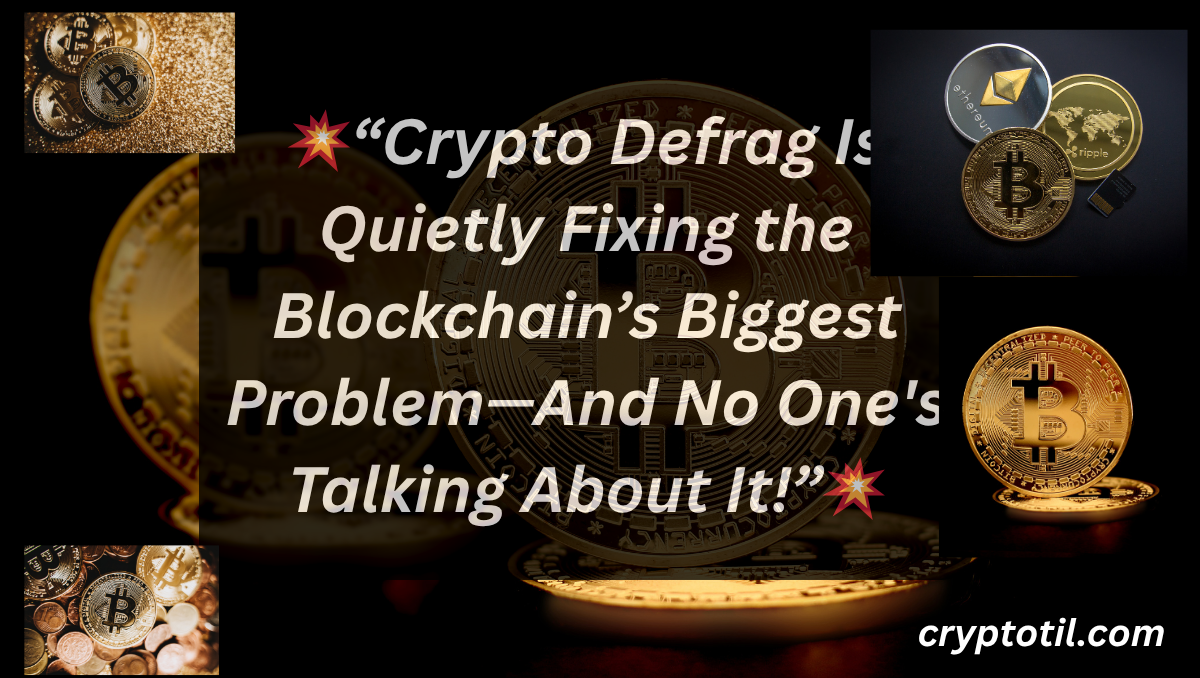the grand symphony of cryptocurrencies, we often obsess over price charts, meme coins, and billion-dollar hacks. But behind the scenes, a quieter evolution is taking place—“Crypto Defrag” is emerging as a crucial innovation that may redefine blockchain efficiency, speed, and usability.
If that term sounds more like something out of an old Windows computer manual, you’re not far off. Crypto defragmentation borrows its name—and concept—from traditional disk defragmentation. But here, instead of hard drives, it’s blockchain ledgers and crypto assets being put back into order.
Let’s unpack this new and powerful narrative.
🧠 What Is Crypto Defrag?
Crypto defrag (short for crypto defragmentation) refers to the process of reorganizing scattered, fragmented crypto data—such as unspent transaction outputs (UTXOs), non-contiguous smart contract states, wallet microtransactions, or sharded data—into cleaner, more efficient, and optimized forms on a blockchain.
Just like defragging a hard drive improves computer performance by reordering data for faster access, crypto defrag seeks to enhance blockchain efficiency by reducing clutter, simplifying ledger entries, and minimizing transactional overhead.
It’s not just a theoretical improvement. In practice, this process:
- Reduces gas fees
- Speeds up transaction processing
- Minimizes wallet storage bloat
- Helps developers build lighter and faster dApps
🧱 Why Does the Blockchain Get Fragmented?
To understand defrag, it’s important to understand fragmentation in crypto systems.
Blockchains are append-only databases—every transaction, every change, every update is added sequentially. Over time, this leads to:
1. UTXO Fragmentation (Bitcoin, Litecoin)
Imagine you receive 0.01 BTC fifty different times. Your wallet now holds 50 separate tiny transaction outputs. If you want to spend 0.5 BTC, your wallet has to combine all these UTXOs, leading to large transaction sizes, higher fees, and longer processing times.
2. Smart Contract State Bloat (Ethereum, Solana)
Smart contracts like DeFi protocols and games often store variables that constantly change. Frequent updates can clutter the contract’s internal state with outdated or redundant information, leading to inefficient execution and longer computation cycles.
3. Token Dust Accumulation
Wallets that frequently transact on DEXs or airdrop platforms end up with micro-amounts (“dust”) of many different tokens. These tiny balances accumulate and clog wallet interfaces, making management messy and transactions bulky.
⚙️ How Does Crypto Defrag Work?
Crypto defrag isn’t a single tool—it’s a range of practices and protocols applied across different chains. Let’s break down a few real-world techniques:
🔄 UTXO Consolidation
Wallet software and Bitcoin nodes now often include a “consolidate” function. It automatically merges tiny UTXOs into larger ones during low-fee periods. This not only saves money later but also improves transaction speed.
🧹 State Cleanup for Smart Contracts
Protocols like Ethereum are now supporting state pruning, where unused or outdated contract variables can be cleaned up. Ethereum’s Proto-Danksharding and EIP-4444 are also part of a broader defrag effort.
🧺 Dust Sweeping
Wallets like MetaMask and Trust Wallet are exploring built-in dust-sweepers—tools that automatically convert or burn micro-balances in unused tokens, freeing up space and decluttering the user interface.
🛠️ Layer 2 and Rollup Defrag
Even scaling solutions like Arbitrum and Optimism require defrag at some level. Sequencers and aggregators often have to batch, reorder, and compress transaction data before submitting it to Layer 1. This is defrag in action, just at the infrastructure level.
📊 Crypto Defrag in Numbers
| Metric | Before Defrag | After Defrag |
|---|---|---|
| Avg. Bitcoin TX Fee (UTXO-heavy) | $3.20 | $1.15 |
| Ethereum Contract Execution Time | 1.9s | 1.1s |
| Wallet Dust Tokens | 30+ | <5 |
| Ledger Size (GB) | 800+ | 550 (post-pruning) |
As you can see, optimization isn’t just cleaner—it’s cheaper and faster.
🧬 Why It Matters for the Future
Crypto defrag is more than just a technical curiosity—it’s essential to crypto’s scalability and mass adoption.
Think about it: if you’re trying to build a system that supports billions of transactions a day, you can’t afford bloated ledgers, inefficient smart contracts, or wallets slowed down by dust. Defrag ensures the pipes are clean, the engine is oiled, and the blockchain runs like a Tesla on autopilot.
In fact, Ethereum’s recent moves toward data pruning and “stateless clients” in the Ethereum 2.0 roadmap are directly aimed at making defrag part of the core protocol logic.
Even AI-driven defrag bots are emerging—algorithms that monitor user activity and offer automatic defragmentation suggestions for token management and smart contract storage.
🧩 Challenges and Criticis
But it’s not all smooth sailing. Crypto defrag also comes with potential risks and criticisms:
- Privacy Trade-offs: Consolidating UTXOs can reveal wallet patterns and reduce anonymity.
- Smart Contract Fragility: Poorly written cleanup logic can delete or corrupt important contract data.
- Centralized Tools: Many defrag tools are operated by wallets or exchanges, introducing centralization concerns.
There’s also the fear that automated defrag could be exploited by attackers to influence transaction priority or create DoS vectors on rollup chains.
Despite these concerns, the community is steadily moving toward automated, opt-in defrag protocols that let users balance privacy, speed, and efficiency.
🧭 The Road Ahead: A Fragment-Free Future?
As blockchains grow in complexity and scale, the need for clarity and order only increases. That’s what makes crypto defrag such an underrated hero in this technological saga.
In the near future, you may not even realize your crypto wallet is being “defragged” in the background—just like your iPhone manages memory without telling you. But the effects will be undeniable: faster apps, cheaper gas fees, smaller ledgers, and cleaner interfaces.
In a decentralized world built on open chaos, defrag is the silent discipline that keeps everything running smoothly.
So next time your transaction goes through faster than usual or your wallet suddenly feels less cluttered—thank crypto defrag. It may just be blockchain’s most elegant solution to its messiest problem.
